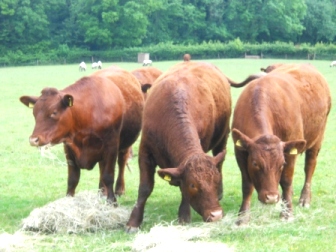Still cooking, still learning
The weather’s turned cold and from wandering around in t-shirts and raincoats, we’re now bundled up in fleeces, hats, gloves and scarves as the northerly wind whistles down the river valley. At least it’s now stopped raining.
From a foodie point of view it means we can rustle up some slow-cooked heart-warming dishes, putting them in the oven in the morning and coming back hours later when it’s time to eat.
Ox-tail is definitely one of our favourites. Unfortunately cattle only have the one tail (err, yeah…) which means with everyone else (and chefs) enjoying this meltingly tender stew, the price has gone up from its cheap and cheerful base a few years ago. So what do we turn too when the butcher’s run out of oxtails? Beef cheeks have been a big winner – great lumps of muscle which spend their entire life constantly chewing grass.
Another newer favourite is beef neck which we hadn’t used or even come across before Christmas but it came in our meat box from our friends at Pipers Farm. If you think about it, again this muscle spends its life lifting and lowering the massive head on a bullock as it reaches down to chomp on grass. This forms the perfect bit of meat for slow-cooking – hard working, dense muscle with a good marbling of fat that will break down to become tender in a cool oven.
All these along with chuck steak make great stews and casseroles. Here’s one of my favourite oxtail recipes –
1 oxtail, jointed (or a kilo of chuck steak or beef neck cut into 5cm chunks, or 4 beef cheeks)
1 large red onion, peeled and sliced
4 carrots, peeled and chopped into large pieces
1 orange, halved
1 cinnamon stick
4 sprigs fresh thyme
600ml beef or chicken stock
150ml red wine
1tbsp cornflour mixed with 2tbsp of the red wine
Salt and pepper
1. Heat the oven to 110C.
2. Mix everything together in an ovenproof pan. Put a piece of foil over tightly the top and put on the lid so you create a tight seal.
3. Put the pan in the oven for 8 hours.
4. Cool the casserole and when cold, put in the fridge overnight to firm up the fat that will have come to the surface.
5. The next day, pick off the fat and discard and gently heat up the stew when you want to eat until bubbling and hot.
6. Fantastic served with creamy mashed potatoes and stir-fried Savoy cabbage.
We met up with Henri and Peter from Pipers Farm last week and they very generously brought us a piece of their fantastic chuck steak. As ever, I asked them what they would do with it and Peter said he’s been grilling it over a very high heat and serving it as he would a rump steak.
Now I’ve never considered this before and was pretty surprised– chuck steak, I’ve been taught, has always been for slow-cooking so we thought we’d give it a go. David heated a griddle pan until super-hot on the hob. He then rubbed a little olive oil and seasoning into 2 pieces of the steak and griddled them very quickly – 3 minutes each side until good and charred. A few minutes to rest the beef and it ate fantastically – just like a rump steak. That’s why I love cooking – always something to learn….


